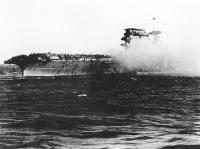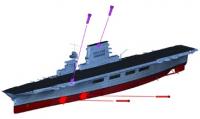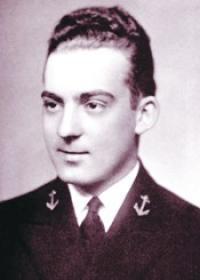Written By: Sam Ghaleb, Ridgecrest, Calif.

Crew abandoning USS Lexington during Battle of the Coral Sea.


Location of hits on Lady Lex.

Lt. Milton E. Ricketts
Seventy years ago, The Battle of Coral Sea was fought between the U.S. Navy and the Imperial Japanese Navy, the two most powerful navies in the world at the time. The battle has gone into history as the first aircraft carrier versus aircraft carrier naval engagement in which the two opposing fleets never sighted each other. The outcome of the battle has been called a Japanese tactical victory and a strategic defeat. The Australians called it the battle that saved Australia.
In the spring of 1942, the Japanese army wanted to complete the conquest of the south pacific by securing the rest of New Guinea, and specifically the major base of Port Moresby. This move by the Japanese was designed to knock Australia out of the war. The Allies on the other hand, including the U.S., and Australia, gathered a large fleet to repel the Japanese invasion fleet.
Admiral Yamamoto on the other hand, preoccupied with planning for the decisive battle with the U.S. Navy, the Coral Sea operation, to him, was a diversion. However, he allowed it to go forward because it looked so easy for the experienced Imperial Japanese Navy.
The operation to secure the south pacific was named by the Japanese as plan MO. Yamamoto’s preoccupation with plan MI – the Japanese code name for the operation to attack and occupy the Island of Midway - meant that operation MO had to make do as an economy of force operation. The command of this operation was given to Admiral Shigeyoshi Inouye of the Imperial Japanese Navy Fourth Fleet.
The planning for the operation was initiated in March 1942, and the forces involved were to accomplish several objectives. These were, to seize the Australian held Port Moresby in New Guinea, establish sea plane bases on the island of Tulagi in the Solomon Islands, and draw the American carriers into battle and sink them. To accomplish all this in mind, Admiral Inouye divided his force into five separate task groups. As was typical throughout the war, the Japanese naval plan for the Port Moresby invasion was complex and required a high level of coordination. Also, as was typical, the Japanese assumed that the Americans would play a passive role and would do "what they were supposed to do" while exhibiting little initiative. As events would prove, these were two huge mistakes.
The Japanese intent in using five separate task groups was to achieve strategic surprise by attacking many points at once. That would, in theory, overwhelm the U.S. ability to react.
The Japanese remained confident, however, that they could win at the Coral Sea with a minimum of force.
The Japanese naval armada assembled for the Coral Sea operation included two fleet carriers the Zuikaku and Shokaku (veterans of the attack on Pearl Harbor), the light fleet carrier Shoho, 9 cruisers, 15 destroyers, 7 submarines and numerous auxiliary vessels and transports. The main invasion force that was set up to take Port Moresby itself, came from Rabaul in New Britain and the covering strike force which included the two fleet carriers came from the main fleet base on Truk island. It was understood that the main invasion force would attract much of the attention of the U.S. fleet, so the basic idea was for the Japanese carrier strike group to ambush the Allied fleet from the rear.
While the Japanese fleet was assembling and getting ready for action, the U.S. code-breakers were hard at work deciphering the intercepted Japanese communications. Though not a perfect science, the information obtained allowed Admiral Nimitz headquarters to make a good guess as to the expected Japanese actions.
With the best information available, Admiral Nimitz gave Admiral Fletcher command of Task Force 17 which included two fleet carriers the USS Lexington, and the USS Yorktown and sent it into action accompanied by 9 cruisers, 13 destroyers, 11 submarines, and two fleet replenishment oilers. It’s worth noting that the U.S. fleet going into action included two Australian warships; the heavy cruiser HMAS Australia, and the light cruiser HMAS Hobart.
The battle of Coral Sea started on May 4th after the Japanese landed and occupied the Island of Tulagi. The U.S. fleet responded on that day with an air strike from the Carrier USS Yorktown, one Japanese destroyer and a transport were heavily damaged and beached.
Bad weather on May 5th and May 6th allowed neither attacking force to spot one another. After searches resumed on the 7th, the light Japanese carrier IJN Shoho - able to field just 21 aircraft - fell victim to U.S. dive and torpedo bombers. The Shoho was hit by thirteen direct bomb hits, several torpedoes and a crashing SBD Dauntless (with the loss of its two-man crew); she was set ablaze and sank. In turn, the U.S. oiler Neosho, and the destroyer Sims were sunk by Japanese air strikes.
On May 8th, the two opposing carrier groups spotted one another in full, each launching as many aircraft as they could muster. The Japanese fleet carrier Shokaku was hit twice by U.S. dive-bombers from USS Yorktown. The damage to Shokaku was extensive and completely limited her aircraft-launch capacity for the duration of the battle. Later that day, the Yorktown was spotted by a Japanese strike group made of 69 dive and torpedo bombers. The Yorktown was hit by a bomb that penetrated the flight deck, exploded inside damaging her but not taking her out of the fight.
The USS Lexington was less fortunate. Japanese torpedo bombers zeroed in on her and hit her twice. Dive-bombers swooped in and added an additional two direct hits upon her structure, jamming her elevators in the raised position. However, her flight deck had not sustained any damage and she - more or less - remained operational. The direct hits did cause internal gas leaks that eventually ignited, generating fires that proved beyond control for the damage crews. For all intents and purposes, the USS Lexington was a loss. Much of her crew was rescued and relocated to waiting USN ships of the Task Force and her remaining aircraft found new homes on the damaged - but still functional - USS Yorktown. Lexington was abandoned, scuttled and eventually sunk by torpedo. The USS Lexington was the largest U.S. warship sunk in World War II. A day earlier, Admiral Inouye, ordered the Port Moresby invasion force to turn back and head for Rabaul.
The Battle of Coral Sea, though technically a victory for Japan, was nonetheless a major setback to its plans to complete the dominance of the Pacific. The invasion of Midway Island was the next pressing action for the Japanese Imperial Navy. But with two fleet carriers absent, one heavily damaged, and the other needing major overhaul, this would prove decisive for the incoming Battle of Midway.
Ironically, the USS Lexington on 20 February 1942, during a raid on the Japanese base of Rabaul, was saved by Lt. Edward “Butch” O’Hare, who shot five Japanese bombers trying to attack the Lexington and became the first U.S. Navy ace in the Pacific War.
One of the heroes of the Battle of Coral Sea was Lt. Milton Ernest Ricketts, a native of Baltimore, Maryland. His extraordinary and distinguished gallantry above and beyond the call of duty as an officer in charge of the Engineering Repair Party of the USS Yorktown, saved the carrier from being destroyed by the flames of the bomb hit. For his action, Lt. Milton Ernest Ricketts was awarded the Congressional Medal of Honor Posthumously. One can say that his action to save the Yorktown had enabled the carrier to reach Pearl Harbor, get repaired, with strict orders from Admiral Nimitz to finish the job within 72 hours. The carrier was able to sail on 30 May 1942 as the core of Task Force 17 to participate in the battle of Midway. Without the Yorktown at Midway, who knows what would have happened.
Next week: The Capture of Kurch
«Go back to the previous page.



